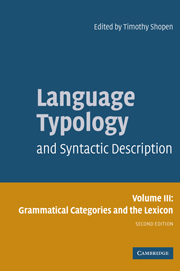Book contents
- Frontmatter
- Contents
- List of figures
- List of tables
- List of contributors
- Acknowledgements
- List of abbreviations and symbols
- 1 Typological distinctions in word-formation
- 2 Lexical typologies
- 3 Inflectional morphology
- 4 Gender and noun classes
- 5 Aspect, tense, mood
- 6 Lexical nominalization
- Bibliography
- Language index
- Subject index
1 - Typological distinctions in word-formation
Published online by Cambridge University Press: 29 December 2009
- Frontmatter
- Contents
- List of figures
- List of tables
- List of contributors
- Acknowledgements
- List of abbreviations and symbols
- 1 Typological distinctions in word-formation
- 2 Lexical typologies
- 3 Inflectional morphology
- 4 Gender and noun classes
- 5 Aspect, tense, mood
- 6 Lexical nominalization
- Bibliography
- Language index
- Subject index
Summary
Introduction
This chapter deals with patterns of word-formation, their classification and parameters of cross-linguistic variation. Grammatical words (section 1) in most languages have an internal structure; the typological parameters which account for their cross-linguistic variation are discussed in section 2. Word-formation processes correlate with syntax in different ways depending on language type. One such word-formation process – known as ‘the most nearly syntactic of all’ (Mithun (1984)) – is noun incorporation, discussed in section 3.
The structure of words in a language can be more or less iconically motivated (see section 4). Word-formation, traditionally, falls into compounding and derivation. A compound consists of morphemes which could be free (see section 5), while derivation involves the use of different classes of bound morphemes and of morphological processes to form words (see section 6). Word-formation processes vary in terms of their productivity – see section 7. Word-formation processes are prone to distinct patterns of grammaticalization and lexicalization – see section 8. A brief summary is given in section 9, and in section 10 I provide suggestions for field workers describing word-formation in previously undocumented or poorly documented languages.
The word
Word-formation accounts for the structured organization of the lexicon. The lexicon is usually conceived of as a list of the form–meaning correspondences conventionalized by speakers, but which are largely arbitrary. However, this list may be structurally organized.
- Type
- Chapter
- Information
- Language Typology and Syntactic Description , pp. 1 - 65Publisher: Cambridge University PressPrint publication year: 2007
- 40
- Cited by



